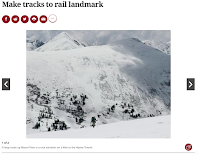Reflections on, insights about, research into, and visits to the remnants of the Colorado and Southern narrow gauge.
Friday, April 30, 2021
A Plan to Repair the Palisades: Is there finally some steam behind it?
Sunday, April 18, 2021
Two views of C&S 74 - 1991 & 2003
I finally got around to scanning some old photos of mine, I found photos of two different visits to C&S 74 when she was on display in Boulder. The first three photos are from 1991 where the consolidation's tender is carrying the emblem of its first railroad, the Colorado and Northwestern where it carried the number 30. The engine was placed here in 1952 through the work of Dr. John B. Schoolland, who got it from the Rio Grande Southern, on a piece of track near the former site of the depot and facing the mountains she once traversed.
The chain fence is quite light surrounding the train at this time.
Saturday, April 17, 2021
To Alpine Tunnel by snowshoes, skis, or boots
 |
| The Denver Post |
others made attempts to reach the west portal of Alpine Tunnel in winter using snowshoes and at other times cross country skis. On one of the trips, the group left Pitkin in the morning, put on skis at Quartz, and, 10 hours later, returned to Pitkin after sunset.
 |
| from The Denver Post |
I have never been to the tunnel in the winter, though, I did see snow on the way to the east portal in June once. It would be stunning to see the area in the winter to get a feel for what it must have been like to attempt to operate the line in those conditions. As I have read in Daniel Edward's South Park Line history books, it is clear that the railroad usually stopped running the line for months, sometimes not opening again until well into the summer due to the snow.
 |
| from Historic Alpine Tunnel by Dow Helmers |
Thursday, April 8, 2021
Following the C&S from Quartz to Midway Tank (video)
My previous video followed the line from Pitkin to Quartz.
This video covers the stretch of DSP&P/C&S Railway right-of-way from the townsite of Quartz to Midway Water Tank, following in the "footsteps" of eastbound C&S mixed train 93.
Besides photos at Quartz and trains leaving Midway Tank, I haven't found any photos of this stretch during its years of operation as a railroad. While a few spots of rock cribbing are pointed out along the way, you will have to content yourself with the incredible scenery and the wonder that a railroad line could be built so high up on the side of a mountain overlooking a stunning valley. Some spots make the precarious drop off to the right look quite frightening!











